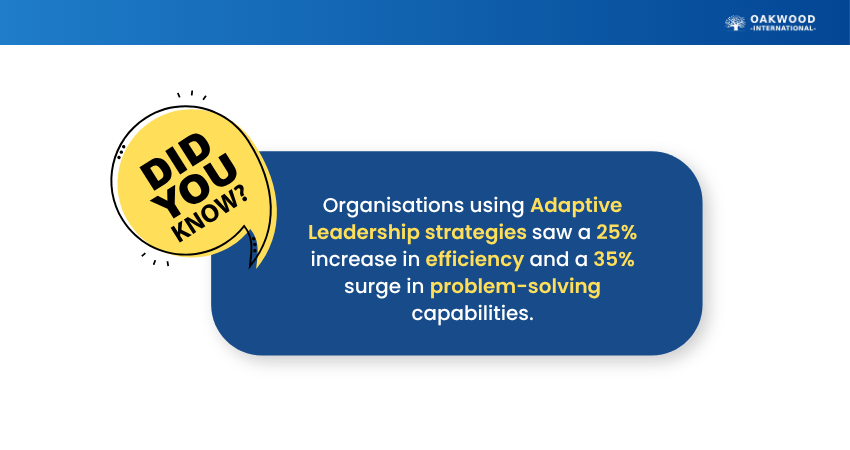Table of Contents


Change is always inevitable, but how we lead through it defines our success. In a world where uncertainty has become the new normal, Traditional Leadership styles often fall short. Rather than relying on rigid strategies, there are leadership styles that inspire collaboration, learning, and help teams adjust to evolving challenges. One such style is Adaptive Leadership.
It encourages leaders to embrace challenges as opportunities for growth, helping teams innovate and unite even in the face of constant transformation. In this blog, we’ll explore what Adaptive Leadership is, its principles, and real-world examples. Let’s dive in!
What is Adaptive Leadership?
Adaptive Leadership is a leadership approach designed for complexity, change, and uncertainty. It focuses primarily on collaboration, learning, and flexibility. It encourages leaders to engage their teams in problem-solving, empowering everyone to contribute ideas and adapt to evolving challenges with confidence.
The Adaptive Leadership style believes in shared responsibility. It makes leaders listen to different perspectives and encourages everyone to take part in solving problems. This helps people change their thinking and behaviour as new situations arise.
The Four Main Principles of Adaptive Leadership
The principles of Adaptive Leadership help leaders support their teams and lead them smoothly through change. Let's check what those principles are:

1) Emotional Intelligence
Emotional intelligence is the ability to understand your own emotions and those of others. Leaders who use this skill can connect better with their teams and build stronger relationships.
1) Helps you to show empathy and care for your team members
2) Makes it easier to handle conflicts calmly
3) Supports better communication during stressful situations
4) Builds trust so people feel safe to accept and adapt to change
2) Organisational Justice
Organisational justice is about being fair, open, and respectful in the workplace. When employees feel treated fairly, they are more likely to trust their leaders and support new ideas.
1) Ensures everyone is treated equally and feels valued
2) Encourages honest communication and feedback
3) Builds trust, reducing fear and resistance during change
4) Helps create a safe and positive workplace for everyone
3) Development
Development focuses on continuous learning and growth. Adaptive leaders encourage people to learn new skills, improve themselves, and be open to change.
1) Promotes regular learning through training and mentoring
2) Helps people learn from mistakes instead of fearing them
3) Builds confidence to handle new or difficult situations
4) Inspires creativity and innovation in the workplace
4) Character
Character means having integrity, honesty, and strong values. Leaders with good character earn respect, inspire others and become a positive example for their teams.
1) Encourages doing the right thing, even when it is hard
2) Builds trust through honesty and consistency
3) Creates a respectful work culture
4) Motivates teams to take initiative and learn from failure
Empower yourself to lead with impact with our CMI Level 4 Certificate in Management and Leadership Training – Register now!
Key Traits of Adaptive Leadership
While principles give us a foundation, the traits of Adaptive Leadership describe how leaders have to behave. Some of the key traits include:
1) Goal-oriented: They focus on long-term goals and make sure every action supports the bigger picture.
2) Open-minded: They listen to new ideas and see mistakes as part of learning.
3) Appreciates Challenges: They view problems as chances to improve and encourage creative problem-solving.
4) Committed: They stay focused and patient, knowing that real change takes time.
5) Proactive: They plan ahead, spot issues early, and take quick action.
6) Curious: They ask questions, explore new ideas, and aren’t afraid of uncertainty.
7) Experimental: They try new things, learn from experience, and adjust as needed.
8) Emotionally Aware: They understand people’s feelings and support them during change.
Why Adaptive Leadership Works?
Adaptive Leadership works for all businesses and organisations because of the following reasons:
1) Handles Uncertainty: Leaders stay calm and focused when things are unpredictable
2) Encourages Innovation: Teams feel free to share ideas and learn from mistakes
3) Motivates People: Everyone feels included and valued in the process
4) Promotes Teamwork: Open communication builds stronger, connected teams
5) Encourages Inclusivity: Involves people with different ideas and lets everyone take part
6) Promotes Adaptability: Helps teams stay flexible and change direction when needed
Advantages of Adaptive Leadership
Adaptive Leadership has many benefits, especially for organisations that face constant change. Below are some of the advantages of implementing it:
1) Embracing Change Positively
Adaptive leaders see change as a chance to grow, instead of something to fear. They use change to improve systems, inspire creativity, and move the organisation forward.
1) Encourages a positive attitude towards change
2) Gives chances for innovation and new ideas
3) Helps companies stay relevant in changing trends
4) Reduces fear and resistance among employees
5) Turns challenges into learning opportunities
2) Promoting Inclusivity in Teams
Inclusive leaders make sure everyone’s ideas and perspectives are taken into consideration. They value ideas from all team members, creating a fair and open workplace.
1) Builds trust and teamwork across all levels
2) Aims for open and honest communication
3) Makes employees feel valued and respected
4) Unites various ideas and perspectives together
5) Creates a friendly and positive company culture
3) Developing Adaptive Thinking
Adaptive leaders and teams can adjust quickly to changes or unexpected challenges. This flexibility helps them stay strong and competitive.
1) Encourages smart decision-making
2) Helps teams respond well to new challenges
3) Builds confidence during uncertain times
4) Balances short-term action with long-term goals
5) Gives companies an edge in competitive markets

4) Fostering Employee Growth
Adaptive Leadership helps people learn new skills and grow in their roles. It aids them in developing through experience, feedback, and teamwork.
1) Promotes learning and personal growth
2) Allows employees to take initiative
3) Builds leadership and problem-solving skills
4) Prepares people for future roles
5) Creates a capable and motivated workforce
Develop practical leadership skills that make a difference with our CMI Level 4 Award in Management and Leadership Training – Join soon!
Disadvantages of Adaptive Leadership
Adaptive Leadership is effective for teams but not always easy to apply. Here are its disadvantages:
1) Challenging Mindset Shifts
1) Everyone needs to be open to change and learning
2) Some people may find it hard to let go of old habits
3) Changing how people think takes time and effort
2) Lack of Recognition
1) Leaders have to admit when old methods no longer work
2) This can upset people who helped create those systems
3) Some may feel their past work isn’t valued anymore
3) Leader Hesitancy
1) Some employees may fear learning new ways of working
2) Resistance to change can delay progress
3) People may worry about making mistakes or losing control
4) Power Imbalance
1) Sharing decision-making can make some leaders uncomfortable
2) Those used to being in control may resist this change
3) It can cause confusion until roles are clearly defined
The Adaptive Leadership Model
The Adaptive Leadership model has three steps. They help leaders understand what the problems are, try new ideas, and find what works best for their teams. Let's check those three steps:
1) Diagnosis: Leaders begin by finding what is working well and what isn’t. They listen to feedback, analyse challenges, and decide which areas need improvement or change.
2) Experimentation: After that, leaders make their teams test new ideas and take smart risks. By trying different approaches, they can find better ways of doing things.
3) Assessment: Finally, leaders review whether the new ideas worked or not. They collect feedback and results to decide whether to keep, change, or stop certain methods.
Real-world Example of Adaptive Leadership
Imagine a mid-sized technical company where creativity has slowed, and team morale is low. A new leader comes and introduces the Adaptive Leadership approach. Rather than forcing new rules on the employees, they talk with the team to understand what their real issues are. Together, they appear for workshops, test small ideas, and focus on learning instead of blaming mistakes.
Over time, employees feel more involved and confident to try new things. The company becomes more creative, flexible, and positive. This example shows how Adaptive Leadership helps teams grow through collaboration and continuous learning.
Real-world Example:
A real example of Adaptive Leadership is Satya Nadella, CEO of Microsoft. When he took charge in 2014, he shifted the company’s rigid culture toward a “growth mindset,” encouraging learning, collaboration, and innovation. His adaptive approach revitalised Microsoft, driving success in Cloud Computing and Artificial Intelligence (AI).
Conclusion
Adaptive Leadership is all about leading with flexibility, empathy, and courage in times of change. It teaches leaders to listen, learn, and lead their teams through uncertainty instead of relying on fixed plans. It reminds us that true leadership isn’t about having all the answers but about helping others discover them together.
Turn your management potential into real leadership power with our CMI Level 4 Training – Begin today!


 Back
Back



 Back to Catagories
Back to Catagories





 + 44 7452 122728
+ 44 7452 122728










